1998 PONTIAC GRAND PRIX air condition
[x] Cancel search: air conditionPage 276 of 402

Section 6 Service and Appearance Care
Here you will find information about the care of your vehicle. This section begins with service and fuel informa\
tion,
and then it shows how to check important fluid and lubricant \
levels. There
is also technical information about your
vehicle, and
a part devoted to its appearance care.
6-2
6-3
6-5
6-6
6-8
6-8
6-
13
6-20
6-22
6-26
6-32
6-33
6-36
6-37
6-44 Service
Fuel
Fuels in Foreign Countries
Filling Your Tank
Filling a Portable Fuel Container Checking Things Under the Hood
Engine Oil Air Cleaner
Automatic Transaxle Fluid
.
Engine Coolant
Windshield Washer Fluid
Brakes
Battery
Bulb Replacement
Windshield Wiper Blade Replacement 6-44
6-52
6-53 6-55
6-56
6-57
6-59
6-60
6-6 1
6-6
1
6-62
6-68
6-70
6-70 Tires
Appearance Care
Cleaning the Inside of
Your Vehicle
Care
of the Safety Belts and Built-in Child
Restraint Harness Cleaning the Outside
of Your Vehicle
Cleaning Aluminum Wheels
(If Equipped)
Underbody Maintenance
Appearance Care Materials Chart
Vehicle Identification Number (VIN)
Service
Parts Identification Label
Electrical System
Capacities and Specifications Normal Maintenance Replacement
Parts
Air Conditioning Refrigerants
Page 279 of 402
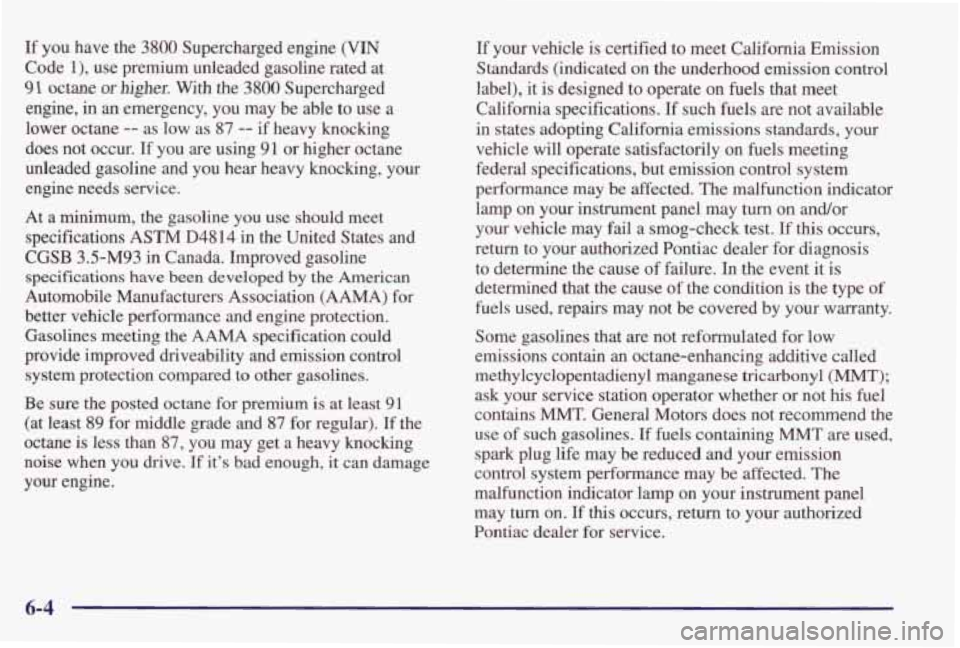
If you have the 3800 Supercharged engine (VIN
Code l), use premium unleaded gasoline rated at
91 octane or higher. With the 3800 Supercharged
engine, in
an emergency, you may be able to use a
lower octane
-- as low as 87 -- if heavy knocking
does not occur. If you are using 91 or higher octane
unleaded gasoline and you hear heavy knocking, your engine needs service.
At a minimum, the gasoline you
use should meet
specifications
ASTM D4814 in the United States and
CGSB 3.5-M93 in Canada. Improved gasoline
specifications have been developed by the American
Automobile Manufacturers Association
(AAMA) for
better vehicle performance and engine protection. Gasolines meeting
the AAMA specification could
provide improved driveability and emission control system protection compared to other gasolines.
Be sure the posted octane for premium
is at least 91
(at least 89 for middle grade and 87 for regular). If the
octane is less than
87, you may get a heavy knocking
noise
when you drive. If it’s bad enough, it can damage
your engine.
If your vehicle is certified to meet California Emission
Standards (indicated on the underhood emission control
label), it is designed to operate on fuels that meet
California specifications. If such fuels are not available
in states adopting California emissions standards, your
vehicle will operate satisfactorily on fuels meeting
federal specifications, but emission control system
performance may be
affected. The malfunction indicator
lamp on your instrument panel may turn on andor
your vehicle may fail a smog-check test.
If this occurs,
return to your authorized Pontiac dealer for diagnosis
to determine the cause of failure.
In the event it is
determined that the cause
of the condition is the type of
fuels used, repairs may not be covered by your warranty.
Some gasolines that are not reformulated for low
emissions contain
an octane-enhancing additive called
methylcyclopentadienyl manganese tricarbonyl
(MMT);
ask your service station operator whether or not his fuel
contains
MMT. General Motors does not recommend the
use
of such gasolines. If fuels containing MMT are used,
spark plug life may be reduced and your emission
control system performance may be affected. The
malfunction indicator lamp on your instrument panel
may turn on. If
this occurs, return to your authorized
Pontiac dealer for service.
6-4
Page 288 of 402
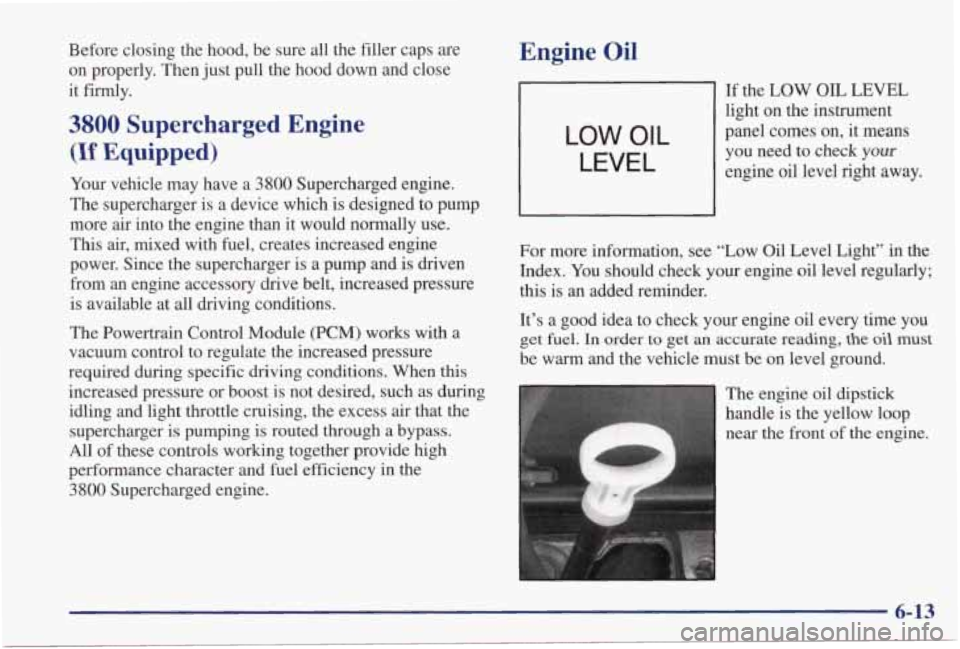
Before closing the hood, be sure all the filler caps are
on properly. Then just pull the hood down and close
it fiiy.
3800 Supercharged Engine
(If Equipped)
Your vehicle may have a 3800 Supercharged engine.
The supercharger is a device which is designed to pump
more air into the engine than it would normally use.
This air, mixed with fuel, creates increased engine
power. Since the supercharger is a pump and is driven
from an engine accessory drive belt, increased pressure
is available at all driving conditions.
The Powertrain Control Module (PCM) works with a
vacuum control to regulate the increased pressure
required during specific driving conditions. When this
increased pressure or boost is not desired, such as during
idling and light throttle cruising, the excess air that the supercharger is pumping is routed through a bypass.
All of these controls working together provide high
performance character and fuel efficiency
in the
3800 Supercharged engine.
Engine Oil
LOW OIL
LEVEL
If the LOW OIL LEVEL
light on the instrument
panel comes on, it means
you need to check
your
engine oil level right away.
For more information, see “Low
Oil Level Light” in the
Index. You should check your engine oil level regularly;
this is an added reminder.
It’s a good idea to check your engine oil every time you
get fuel. In order to get an accurate reading, the oil must
be warm and the vehicle must be on level ground.
The engine oil dipstick
handle is the yellow loop
near the front of the engine.
6-13
Page 325 of 402
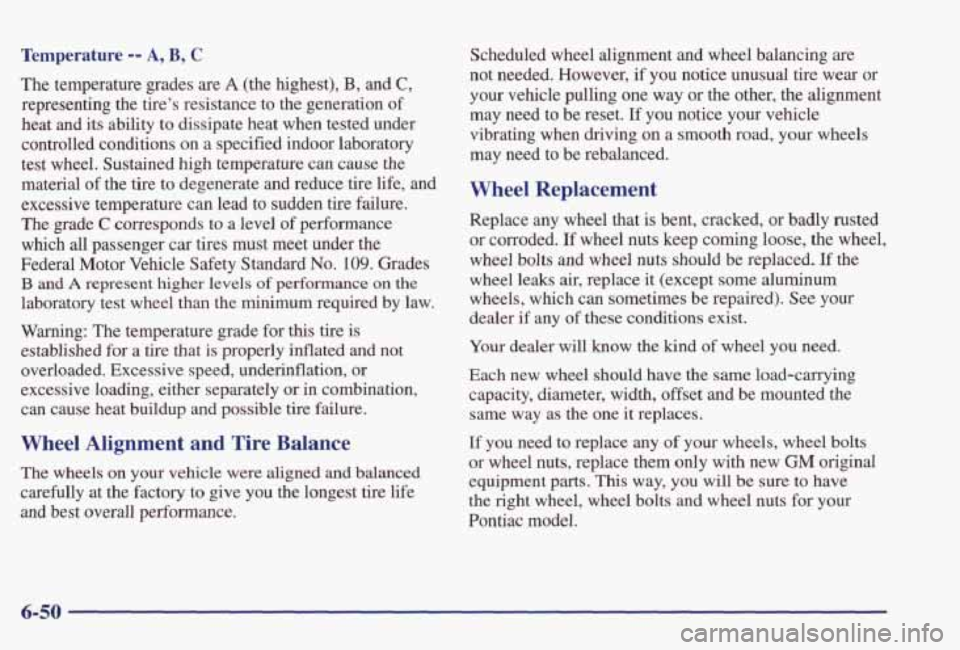
Temperature -- A, B, C
The temperature grades are A (the highest), B, and Cy
representing the tire’s resistance to the generation of
heat and its ability to dissipate heat when tested under
controlled conditions on
a specified indoor laboratory
test wheel. Sustained high temperature can cause the
material of the tire to degenerate and reduce tire life, and
excessive temperature can lead to sudden tire failure.
The grade C corresponds to a level of performance
which
all passenger car tires must meet under the
Federal Motor Vehicle Safety Standard
No. 109. Grades
B and A represent higher levels of performance on the
laboratory test wheel than the minimum required by law.
Warning: The temperature grade for this tire is
established for a tire that
is properly inflated and not
overloaded. Excessive speed, underinflation, or
excessive loading, either separately
or in combination,
can cause heat buildup and possible tire failure.
Wheel Alignment and Tire Balance
The wheels on your vehicle were aligned and balanced
carefully at the factory to give you the longest tire life
and best overall performance. Scheduled wheel alignment and wheel balancing are
not needed. However, if you notice unusual tire wear or
your vehicle pulling one way or the other, the alignment
may need to be reset.
If you notice your vehicle
vibrating when driving on a
smooth road, your wheels
may need to be rebalanced.
Wheel Replacement
Replace any wheel that is bent, cracked, or badly rusted
or corroded. If wheel nuts keep coming loose, the wheel,
wheel bolts
and wheel nuts should be replaced. If the
wheel leaks
air, replace it (except some aluminum
wheels, which can sometimes be repaired). See your
dealer
if any of these conditions exist.
Your dealer will know the kind
of wheel you need.
Each new wheel should have the same load-canying
capacity, diameter, width, offset
and be mounted the
same way as
the one it replaces.
If you need to replace any of your wheels, wheel bolts
or wheel nuts, replace them only with
new GM original
equipment parts.
This way, you will be sure to have
the
right wheel, wheel bolts and wheel nuts for your
Pontiac model.
6-50
Page 334 of 402
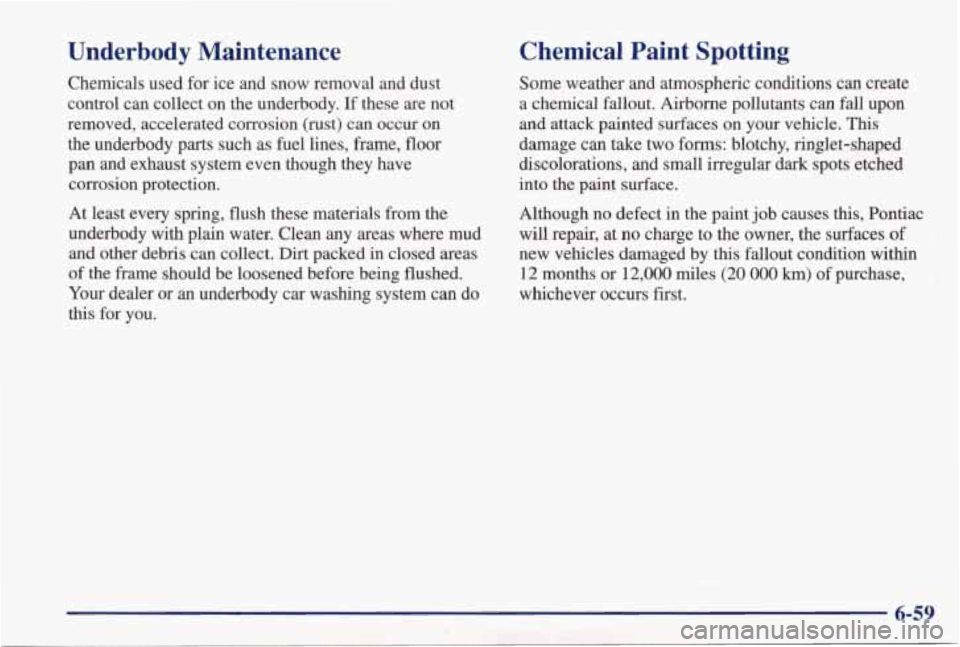
Underbody Maintenance
Chemicals used for ice and snow removal and dust .
control can collect on the underbody. If these are not
removed, accelerated corrosion (rust)
can occur on
the underbody parts such as fuel lines, frame, floor
pan and exhaust system even though they have
corrosion protection.
At least every spring, flush these materials from the underbody with plain water. Clean any areas where mud
and other debris can collect. Dirt packed in closed areas
of the frame should be loosened before being flushed.
Your dealer or an underbody car washing system can do
this for you.
Chemical Paint Spotting
Some weather and atmospheric conditions can create
a chemical fallout. Airborne pollutants can fall upon
and attack painted surfaces on your vehicle.
This
damage can take two forms: blotchy, ringlet-shaped
discolorations, and small irregular dark spots etched
into the paint surface.
Although no defect in the paint job causes
this, Pontiac
will repair, at no charge to the owner, the surfaces of
new vehicles damaged by this fallout condition within
12 months or 12,000 miles (20 OOO km) of purchase,
whichever occurs
first.
6-59
Page 343 of 402

Replacement Bulbs
Exterior Lamps ............... Bulb Number
Back-up ............................... 3 156
Front Parking/Turn Signal
.............. .3357NA
Center High-Mounted Stop
................ 1141
Headlamps HighBeam
........................... 9005
Low Beam ........................... 9006
Front Sidemarker
......................... 194
Rear Sidemarker ......................... 194
Stop/Tail/Turn Signal ..................... 3057
Capacities and Specifications
Please refer to “Recommended Fluids and Lubricants”
in the Index for more information.
Automatic Transaxle with Overdrive
Pan Removal and Replacement ..... 8 quarts (7.5 L)
After Complete Overhaul ......... 10 quarts (9.5 L)
When drainingheplacing converter or auxiliary coolel;
more fluid
my be needed.
Cooling System Including Reservoir
3100 (CodeM) ............... 11 quarts (10.42 L)
3800 (Code K) .............. 12.3 quarts (11.65 L)
3800 Supercharged (Code 1) ... 12.3 quarts (11.65 L)
Refrigerant (R-l34a),
Engine Crankcase (Oil Change with Filter Change)
Air Conditioning*
............ 1.9 lbs. (0.85 kg)
3100 (Code M)
................ 4.5 quarts (4.2 L)
3800 (Code K) ................ 4.5 quarts (4.2 L)
Fuel Tank .................... 18 gallons (68 L)
3800 Supercharged (Code 1) ..... 4.5 quarts (4.2 L)
*See “Air Conditioning Refrigerants ” later in this section.
Note: All capacities are approximate. When adding, be
sure to fill the appropriate level, as recommended
in this
manual. Recheck fluid level after filling.
See “Recommended Fluids and Lubricants” in
the Index
for more information.
6-68
Page 345 of 402

Normal Maintenance
Replacement Parts
......... A1208C
Air Cleaner Filter
Battery
All Engines ..............
3100 (Code M) ......... ........ 600CCA
3800
(Code K) ...................... 690 CCA
3800 Supercharged (Code 1) ........... 770 CCA
All Engines ................. AC PF47
All Engines ...................... CV892C
Engine Oil Filter
PCV
Valve
Radiator Cap
All Engines ... .............. AC RC27
Spark Plugs
3100 (Code M) . . ......... AC Vpe 41-940
Gap: 0.060 inches (1.52 cm)
3800 (Code K) ................ AC Type 41-921
Gap: 0.060 inches (1.52 cm)
3800 Supercharged (Code 1) . . AC Qpe 41-921 or
NGK 5pe PTR4B- 15
Gap: 0.060 inches (1.52 cm)
Wiper Blades
vpe ................................. Hook
Length ................... .20 inches (50.8 cm) -
Air Conditioning Refrigerants
Not all air conditioning refrigerants are the same. If
the air conditioning system in your vehicle needs
refrigerant, be
sure the proper refrigerant is used. If
you’re not sure, ask your dealer.
6-70
Page 347 of 402
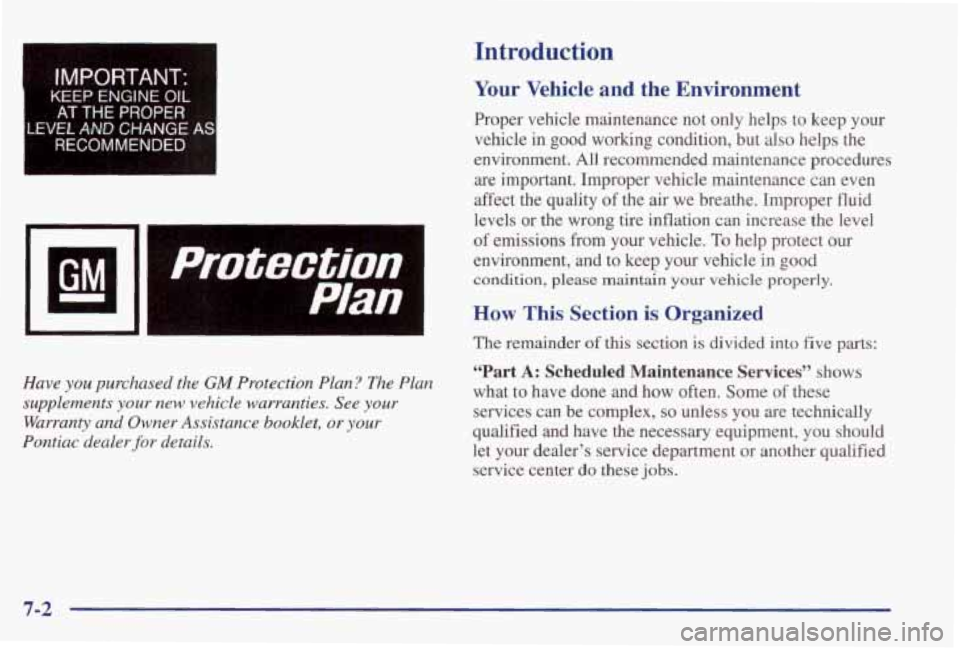
I
tMPORTANT-
KEEP ENGINE OIL
AT THE PROPER
LEVEL AND CHANGE AS
RECOMMENDED I
I
Wl
I Protection 1
Plan
Have you purchased the GM Protection Plan? The Plan
supplements
your new vehicle warranties. See your
Warranty and Owner Assistance booklet, or your
Pontiac dealer for details.
Introduction
Your Vehicle and the Environment
Proper vehicle maintenance not only helps to keep your
vehicle in good working condition, but also helps the
environment.
All recommended maintenance procedures
are important. Improper vehicle maintenance can even
affect
the quality of the air we breathe. Improper fluid
levels or the wrong tire inflation
can increase the level
of emissions from your vehicle.
To help protect our
environment, and
to keep your vehicle in good
condition, please maindn your vehicle properly.
How This Section is Organized
The remainder of this section is divided into five parts:
“Part A: Scheduled Maintenance Services” shows
what to have done and how often. Some
of these
services
can be complex, so unless you are technically
qualified
and have the necessary equipment, you should
let your dealer’s service department
or another qualified
service center
do these jobs.
7-2